by Kelsea Kierstead
MADISON, Wis. – Against the beige, brick landscape on University Avenue stands an oblong building lined with a wall of windows. An abundance of greenery grows on the building’s every floor.
Inside, there is much more growing than indoor aesthetic plants. At the Wisconsin Institute for Discovery, there lives a greenhouse of scientific creativity.
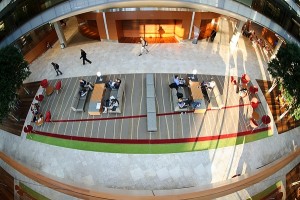
The WID is home to a unique research culture with a goal to promote multidisciplinary research at the University of Wisconsin-Madison. The centrally located space on campus invites multidisciplinary collaboration between exceptional scholars to leverage information intended to better nearly any living community.
“[The WID] provides an environment where people can grow and cross-pollinate [ideas],” explained WID Events and Communications Manager Nolan Lendved.
The publically supported WID houses an array of UW-Madison faculty members, all of whom are encouraged to work loosely underneath the center’s eight current programs.
Lendved refers to the programs as “themes.” Themes are comparable to departments within the existing university structure, except they house a number of cross-disciplinary programs.
“[The WID] is about having a culture of openness where people are able to talk to other people and have new collaborations in a space that they wouldn’t have their departments,” Lendved said.
The researchers most expected to initiate collaboration across themes are Discovery Fellows, the WID’s distinguished scholars.
“The purpose [of Discovery Fellows] is to breach the walls of the themes we have,” he said.
Discovery Fellows work underneath at least one of the themes that span from biological
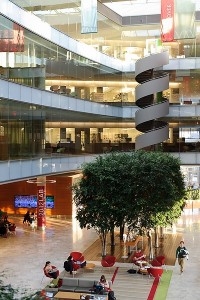
life sciences at the cell level, to computer sciences at the societal level.
One of the themes is Optimization, an initiative that explores the efficiency of mathematical models to improve and manage nearly any data system.
The Optimization group is advised by Discovery Fellow Robert Nowak, one of the many WID leaders nominated to pioneer academic and community collaborations.
PhD candidate Kevin Jamieson has worked closely with Nowak for about five years. He is optimizing the Next System, a working algorithm that organizes data more efficiently.
The program is based upon the machine-learning model called adaptive learning.
The goal of adaptive learning is to better predict human behavior. In theory its applications are limitless, but in reality adaptive learning algorithms need to be tailored to specific problem sets of software developers and researchers.
“The Next System allows [developers and researchers] to perform adaptive learning tasks more efficiently and allows [them] to do this is in a way that is very fast and easy,” Jamieson said.
Undergraduate research assistant Ari Biswas assists Jamieson in visualizing data from the Next System. Biswas explains the ultimate goal of adaptive learning in predicting human behavior that is based upon the user’s previous input.
“The goal of adaptive learning is to ask [the human] better questions,” Biswas said. “With adaptive learning, the questions we ask can be smarter.”
Jamieson spends roughly half of his time proving algorithms theoretically, and half of his time searching for how he can implement the Next System with the real data sets of university researchers.
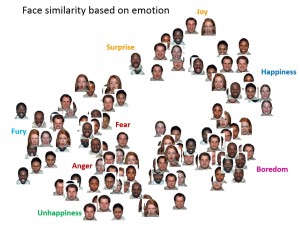
For Jamieson, being surrounded by scholars in biological sciences has given him “the real problems” he needs to make the Next System a tool for any scientist.
“There are a wide variety of disciplines here,” he said. “I’ve started thinking about these adaptive learning problems in biology that I never would have thought of hadn’t I had met some of these biology [researchers] and had conversations with them.”
Cross-pollination between the WID and its university partnerships gives Jamieson applications for the Next System beyond well-funded adaptive learning applications, like online advertisements and song recommendations.
“Talking to people in the psychology department or in the biological science, they have real problems that need to be solved,” Jamieson said. “It’s fun to be working on a problem and help someone out and help them do something they couldn’t do before.”
Research on how word meanings are structured in the brain is the core of UW-Madison Professor Tim Rogers’s research in cognitive neuroscience. His large and complex data sets are difficult and time consuming to process, which could leave valuable data unexplored without using a system like Next.
“Psychologists that have to collect lots of data are kind of out in the cold,” Jamieson said. “I like to work on these problems that are moving science forward.”
Rogers is invested in his partnership with the Optimization group because of its potential to advance any application that measures human behavior through the power of cross-disciplinary collaboration.
“[Novak and Jamieson] have a lot of expertise in the things you can do to efficiently estimate structures. We have a lot of expertise about the kinds of behaviors humans are prone to generate in their system,” Rogers said. “It’s the marriage of theses two [disciplines] that gives us the ability to solve a whole bunch of problems around how human minds work.”
Rogers is testing a hypothesis that contradicts traditional interpretations of brain imaging data. Many cognitive neuroscientists like Rogers are testing whether brain activation for a given mental construct is distributed across a pattern of neurons.
“The hypothesis is that our neural representations of objects and meanings are not localized to individual parts of brain, but distributed as patterns of activities across the brain,” he said.
Rogers and Jamieson met at the Human and Machine Learning Experiments in Theory seminar that meets weekly one semester each year. The cross-disciplinary series gathers scholars from computer science, engineering education and entrepreneurship to discuss intersections between human behavior and machine learning.
According to Lendved, events like HAMLET are one example of the opportunities the WID “culture of openness” creates.
“By bringing [scholars from different fields] into WID, we give them the opportunity to work in and outside campus to do things they wouldn’t get to do in their departments alone,” Lendved said.
Lendved believes Optimization is one of themes that truly builds upon the WID’s approach to science.
“I think Optimization is a really good example of how that interdepartmental collaboration can be really valuable,” he said.
The intersection between Nowak and Jamieson’s optimization of adaptive learning and
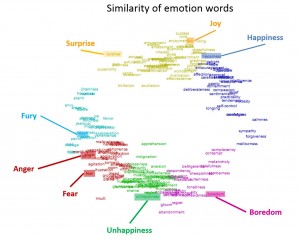
Roger’s exploration of human behavior can result from casual within the WID’s open spaces.
“[The WID] space is designed to aid in collaboration,” Lendved said. “There are a lot of open spaces and we encourage people to get out into those spaces.”
The WID has four levels of open atriums with an array of natural elements, like full-grown trees and walls of waterfalls. In the Town Center on the first floor, there is one main multipurpose conference room and several meeting spaces. The Town Center houses Aldo’s Café, a fair-trade coffee shop, as well as Steenbock’s on Orchard, an on-site restaurant.
The design of the WID building is as innovative as the scholars themselves. According to the Town Center’s mission stated on its website, “the Town Center is a place to gather, share ideas, and celebrate science, creativity and exploration.”
WID faculty and its guests are invited for a tea break at 3 p.m. Lendved describes how a short break from rigorous work keeps researchers fresh by engaging in conversations with scholars from other themes.
“The idea is that hopefully [the space] will spur new collaboration between themes so people aren’t huddled in their little areas,” Lendved said.
For undergraduate Ari Biswas, the WID is a “phenomenal” space that outshines the windowless research labs he has worked in previously.
“[The WID] has kitchens, it even has showers. It makes sure I never leave the place,” he said. “It’s actually a research lab where sunlight comes in. You wouldn’t understand how big of a deal that is.”
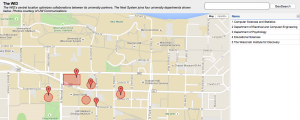
As a university entity unlike most other research centers, the WID owes its vitality to the curious minds that drive innovation.
For the Next System, a more efficient means to analyzing brain imaging data and human responses could lead to monumental findings in biological psychology, or any data-curious entrepreneur with a mobile application start-up.
For Rogers, societal applications of human behavior and computer learning are only the beginning of where graduate students could take their open minds.
“By working together across boundaries, I feel like we have moved science forward while giving our graduate students a leg up in having the kind of expertise that has allowed them to move science forward when they leave UW.”
For more on this topic, click here.
